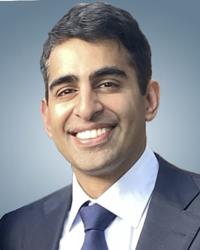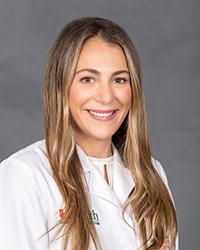What is Facial Paralysis?
Patients who experience facial paralysis or synkinesis (unwanted contractions of facial muscles) may not be able to blink, smile, or move their faces how they want. Facial paralysis can be temporary or permanent, and occurs when the nerves that control facial muscles are disrupted and cannot send a signal. Viruses, trauma from surgery, Bell’s Palsy, autoimmune disorders, and other nerve or muscle conditions can all cause facial paralysis.
Our expert team uses surgical and nonsurgical treatments to support facial reanimation and relieve paralysis or synkinesis. Nonsurgical treatments include Botox® and targeted facial neuromuscular retraining. Surgical options include rerouting or possibly removing nerves, removing muscles, or grafting (transplanting) facial muscles.
At UHealth's Facial Nerve Program, we treat anyone with facial paralysis (temporary or permanent, mild, or severe).
We evaluate and treat a wide spectrum of related conditions in patients of all ages, including infants.
We provide an individualized approach to facial rehabilitation with the expectation that our experts can improve the facial condition, appearance, or function of every qualifying patient.
Through comprehensive consultations, we will discuss the timeline of your facial muscle weakness, diagnose the cause of your facial paralysis, and establish goals for your rehabilitation. We consider all of these factors when designing your personalized treatment plan.
Our multidisciplinary team will explain the recommended sequence of interventions for your care. These may include targeted neuromuscular retraining, chemodenervation (e.g. Botox), in-office procedures, and/or more complicated facial reconstruction surgeries, such as nerve transfers and free muscle transfers.
We treat a variety of facial nerve conditions, including:
- Acoustic neuromas (vestibular schwannomas)
- Autoimmune conditions
- Bell’s Palsy
- Congenital facial paralysis
- Congenital unilateral lower lip palsy (CULLP)
- Facial nerve tumors (e.g., facial schwannoma, geniculate ganglion hemangioma)
- Facial paralysis after head/neck, or ear surgery
- Facial paralysis after parotid surgery
- Facial paralysis caused by blunt/penetrating trauma
- Flaccid facial paralysis (weak muscles)
- Hemi-facial spasm
- Infectious diseases (e.g., ear infections, Lyme Disease, meningitis, HIV, Polio)
- Moebius syndrome
- Non-flaccid facial paralysis (hypertonic, synkinetic muscles)
- Ramsay Hunt Syndrome
- Stroke
- Tumors (e.g., head and neck cancer, facial nerve tumors, brain tumors, glomus tumor)
Procedures and Therapies to Treat Facial Nerve Paralysis:
- Asymmetric facelift
- Brow lift
- Chemodenervation (e.g., Botox)
- Cross facial nerve graft
- Depressor anguli oris (DAO) excision
- Depressor labii inferioris (DLI) excision
- Eye care
- Facial nerve decompression
- Facial nerve repair
- Fillers and grafts
- Gracilis free muscle transfer
- Hypoglossal to facial nerve transfer
- Masseteric to facial nerve transfer
- Medical therapies
- Physical therapy
- Platinum eyelid weight placement
- Selective denervation/neurolysis
- Static suspension
Diagnostic Testing Includes:
- Blood work
- EMGs
- ENOGs
- Facial nerve imaging (CT scans and MRI)
We will also take high quality photos and videos of your face at your initial consultation and subsequent follow-up appointments to document the visual changes and improvements in your condition.
Life After Surgery
The timeline for your recovery depends on your unique condition and the types of treatments you receive at UHealth. Some procedures (such as platinum eyelid weights and static facial suspension) yield immediate improvements in facial function. Other surgeries (such as nerve repair, nerve transfer, and muscle transfer) can take six to 12 months to provide final results.
Many patients also benefit from nonsurgical approaches including physical therapy and chemodenervation (e.g., Botox), which requires treatments every three to six months. Most patients require multiple types of treatment to address all of their functional needs.
Why Choose UHealth?
Highly specialized, effective treatments for facial nerve dysfunction. UHealth is one of Florida’s only healthcare providers treating facial nerve disorders and paralysis with complex surgeries. UHealth’s ear, nose, and throat specialists have additional training in related facial plastic and reconstructive procedures.
Multidisciplinary team diagnoses and treats complex facial nerve issues. Our team of experts from various subspecialties collaborates to provide you with comprehensive care. Our aim is to help improve your quality of life by restoring facial symmetry and function. The UHealth facial nerve care team includes physical therapists; plastic surgeons; ear, nose, and throat physicians (otorhinolaryngologists); head and neck surgeons; and neurotologists.
Ranked top tier in the nation according to U.S. News & World Report. Surgeons, audiologists, biomedical engineers, speech pathologists, researchers, and psychologists collaborate with many research programs at the University of Miami Miller School of Medicine to deliver the best possible multidisciplinary care to pediatric and adult ear, nose, and throat patients.
World-class care in an academic health system. We are recognized throughout South Florida and the world as a leader in treating conditions and disorders of the ear, nose, and throat. Backed by one of the nation’s top universities, our team uses the latest technologies and research-driven expertise to provide you with superior, personalized care and the best outcomes.
Meet Our Doctors
-

Shekhar Gadkaree, MD
Facial Plastic Surgery -

Liliana Ein, MD
Facial Plastic Surgery, Otolaryngology
Questions? We're here to help.
Our appointment specialists are ready to help you find what you need. Contact us today.